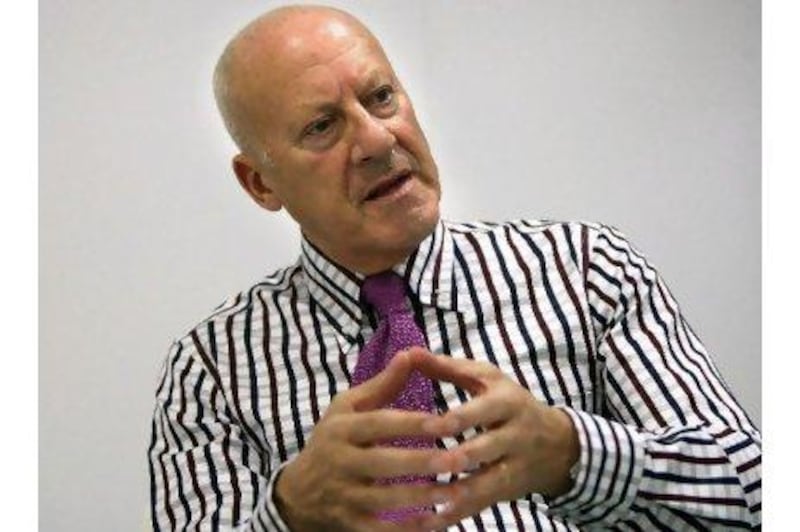The story of Norman Foster is the inspirational tale of a working-class boy who became one of the "starchitects" of his generation, responsible for some of the most important and striking buildings in the world.
Lord Foster was born in 1935 in the northern English town of Stockport, in Lancashire, in a terraced house that backed on to a railway line.
He left school at 16 and did national service in the RAF before he studied at Manchester University School of Architecture and City Planning.
Graduating in 1961, he won a Henry Fellowship to study at Yale in the US, where he was awarded a master's degree in architecture.
He was only 32 when he founded Foster + Partners in 1967 in a flat in London. Since then the company has grown into a superbrand that employs more than 1,000 architects and has project offices in more than 20 countries.
Lord Foster's architecture came of age in the year that the UAE was born, with the breakthrough building he designed in 1971 for the insurance company Willis Faber.
With its organic shape and black, glass walls, the three-storey headquarters materialised like a spaceship in the heart of the Suffolk town of Ipswich, and yet, thanks to its reflective glazing, somehow managed to blend in with the medieval townscape. In 1991, the building became the youngest in the UK to be protected because of its special architectural and historic interest.
The building pioneered energy-conscious design long before the trend for environmentally sensitive developments. This concern for sustainable architecture has found expression throughout Lord Foster's career and is echoed today in Abu Dhabi in his designs for the Aldar Central Market, Masdar City and the Zayed National Museum.
In the past four decades, Lord Foster has worked on everything from urban master plans, airports and civic and cultural buildings to offices, private homes and product design. One recent project was London's new Routemaster, a reworking of the capital's much-loved red bus. In the process, the company has won more than 80 architectural competitions and 470 awards.
Lord Foster has been honoured many times. It is a reflection of the length and breadth of his career that it was as long ago as 1983 that he received the Royal Gold Medal for architecture, an award approved by the Queen and normally given to mark a lifetime of architecture. In 1990, he was knighted and in 1999 was elevated to the UK peerage, becoming Lord Foster of Thames Bank in recognition of the location of his Riverside studios in London. That same year he became the 21st Pritzker Architecture Prize Laureate, following in the footsteps of the Swiss designer Le Corbusier.
Lord Foster says his favourite building is always the one on which he is working, and his designs have left their mark on many cities around the world.
The headquarters of the Hong Kong and Shanghai Bank (1979-1986) gave the former colony's skyline a signature flourish, while London's landscape has been altered dramatically by two buildings in particular: the modified sphere of City Hall (1998-2002), alongside Tower Bridge, and the landmark Swiss Re headquarters (1997-2004), which is known fondly to Londoners as "The Gherkin".
The UK's Stansted Airport (1981-1991) reinvented the rules of airport design, which Lord Foster has gone on to refine in a number of projects, including the spectacular Hong Kong International Airport (1992-1998) and the graceful sweep of Beijing Airport (2003-2008).
Lord Foster's portfolio includes an impressive array of cultural projects, among them the beautiful Great Court at the British Museum (1994-2000), which is the largest enclosed public space in Europe, his symbolic transformation of the German Reichstag (1992-1999) and his wing for the Museum of Fine Arts in Boston, which was opened earlier this month.
Married three times, Lord Foster has five children. A keen cyclist, skier, pilot and collector and restorer of old cars, he lives in an 18th-century Swiss château between Lausanne and Geneva, where he keeps a collection of light aircraft in a personal museum. He regularly flies his own jet.
Non-resident in the UK, in July he gave up his membership of the House of Lords, the upper house of the British parliament, after a change of rules meant he would have to pay tax on money he earned outside the country. He was allowed to keep his title.
In 2000, Lord Foster underwent chemotherapy in a successful fight against bowel cancer, taking inspiration from the story of the Tour de France winner Lance Armstrong's battle with testicular cancer.
"I got through it by reading Lance Armstrong's book," he said later. "I bought a racing bike, and though I didn't quite manage to win the Tour de France, I've cycled ever since."
Aged 75, he has no plans to retire, he told an interviewer this year. "I've never been busier," he said.
"I'm amazed to be here still and doing all this. But then I look at [the architect] Oscar Niemeyer in Rio, who was a hero of mine when I was a student at Manchester. Oscar's still busy at work at 102, so there's hope. In any case, I just wouldn't know how to stop."





